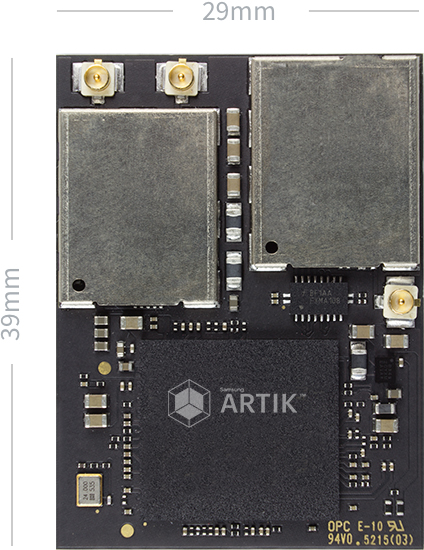At the Samsung Developer Conference in San Francisco last week, Samsung was all about the Internet of Things (IoT), but surprisingly, much of did not revolve around Tizen or SmartThings. Instead, the main focus was on its newly shipping Artik embedded boards, which ship with Fedora.
There was some Tizen related news, however, including a new ”Smart View” SDK for improving mobile connectivity with Tizen-based Smart TVs, as well as a promise to bring Knox security support to Tizen. There were also more details on the upcoming, 64-bit capable Tizen 3.0.

Together, the announcements reflect a more inclusive Samsung. Since it gave up last year on the idea that its Tizen-based Gear watches could only work with Samsung mobile devices, there has been more talk about open standards and cooperation than in the past. The Artik Cloud, for example, not only doesn’t require Samsung devices, Tizen, or a Samsung SmartThings IoT hub, it doesn’t even require Artik boards.
Artik 5 and 10
The Artik platform of computer-on-modules was announced a year ago, but the $100, dual-core, Cortex-A7 Artik 5 did not ship until February. The Artik 10, which combines four Cortex-A7 with four Cortex-A15 cores, began shipping this week for $150. Both modules are available at Digi-Key, with prices including a development board. In addition to these two Linux-ready ARM COMs, Samsung will soon release a 12x12mm, MIPS-based Artik 1 designed for RTOSes. All three modules share multi-layer security with ARM TrustZone support, boot image authentication, secure boot, and secure communication via a secure element. Now, they also share a common IDE and Artik Cloud platform.
There are no names for the processors baked into the Artik boards. The Artik 5’s SoC circuitry includes the mainstream Mali-400 MP2 GPU and supports 720p video, while the Mali 10 moves up to a Mali-T628 MP6, delivering up to 1920×1080@120fps. The boards were initially set to ship with a Yocto Project distribution, but they now run Fedora, while supporting other Linux distros. The 30x25mm Artik 5 provides 512MB of LPDDR3 RAM and 4GB of eMMC flash. The module integrates WiFi, Bluetooth/BLE, and 802.15.4 standards like ZigBee and soon, Thread. The Artik 5 is equipped with a 60-pin connector to link to an SBC-like carrier board. There’s also a 40-pin debug connector, and 47 GPIOs. I/O ranges from MIPI-CSI and -DSI multimedia interfaces to gizmo oriented links such as I2C and PWM.
The 39x29mm Artik 10 has 2GB of LPDDR3 RAM, 16GB of eMMC flash, and similar wireless features. It has an 80-pin carrier connector, and provides more GPIO, and it adds USB 3.0 support. The boards also provide Arduino compatibility, although this appears to refer to the Arduino IDE rather than Arduino shield connectivity.
Artik IDE
Samsung’s Artik IDE is based on the open source, Codenvy-backed Eclipse Che derivative of Eclipse. Samsung claims the Artik IDE is the “first IoT IDE built upon an open source IDE platform.” Designed for building applications for Artik boards, the multi-platform IDE is free to use and redistribute, and offers an open plug-in customization architecture.
Eclipse Che enables the Artik IDE with features like integrated device discovery and management, versioning and deployment, and support for C, C++, Java, JavaScript, Python, and more. This “no-installation browser” IDE provides a runtime for each workspace, greatly speeding setup, says Samsung.
Artik Cloud
Samsung’s Artik Cloud provides open APIs and other tools for securely collecting, storing, and acting on IoT data. It was previewed last year as the SmartThings Open Cloud platform, but perhaps because it’s based more on Samsung’s earlier SAMIio than any technology from its SmartThings home automation subsidiary, Samsung changed the name to Artik Cloud. The software service is free to hobbyists, with tiered subscription pricing for businesses.
While Artik Cloud supports Artik boards for IoT endpoints (Artik 1 and 5) and gateways (Artik 5 and 10), it’s billed as an open data exchange platform for IoT interoperability that can accommodate a variety of devices, applications, and cloud services. According to Computerworld’s Agam Shah, the list includes the Amazon Echo, Nest thermostats, and a wearables including FitBit, Samsung’s Gear smartwatches, and the Raspberry Pi.
At an Artik event at MWC in early March, Samsung mentioned support for the Linux Foundation’s Iotivity middleware standard, as well as connectivity to Microsoft Azure and Amazon Web Services (AWS). The Artik Cloud is similar to Amazon’s AWS IoT managed cloud platform, which supports a variety of endpoints including Linux hacker boards. Key features of Artik Cloud include:
- Device Manifests — Universal language to describe device states and actions, enabling rapid onboarding of devices
- Multi-Protocol Connectors — Device connections via REST/HTTP, Websockets, MQTT, and CoAP
- Cloud Connectors –- Connectivity to “any cloud service”
- Heterogeneous Data Collection — Collects continuous, discrete, real-time, and historical data from any device or third-party cloud
- Two Way Communication — Securely exchange messages both ways between device and cloud
- Data Normalization and Analytics — Access data, statistics, and aggregations with multiple back-ends to store, replicate, and index data
- Security & Privacy — Secure device, app, and user interactions including secure device registration, authentication and authorization, and identity and permissions management
- Developer Tools — Includes open universal access APIs, rules engine, visualization tools, development portal, and support for SDKs, including Tizen 3.0, Android, iOS, and major programming languages
One of the first customers for the Artik Cloud is Legrand which showed off what Samsung calls “the world’s first Thread-enabled IoT light switch.” Built around Artik boards, the device offers Artik security from device to hub to cloud to data management, while adhering to the fundamental protocols of the open source, IPv6/6LoWPAN-based Thread standard. Samsung is a core member of the Google-backed Thread Group, which has developed the mesh networking enabled Thread protocol as an upgrade over similar 802.15.4-based standards like ZigBee.


